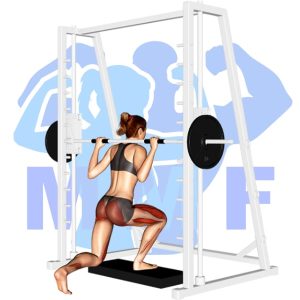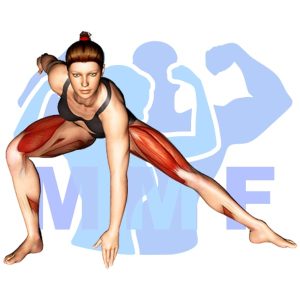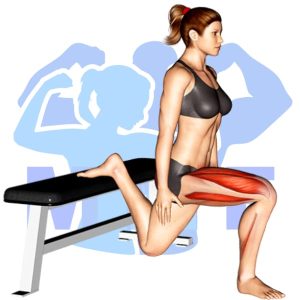Do you struggle with keeping your squats low without toppling over? The infamous squat hold can prove to be a daunting task for those who are just starting out on their fitness journey. Don’t worry! It’s completely normal to feel like your legs are giving out after just a few seconds of holding this position. Even seasoned athletes sometimes struggle with it. However, giving up on this exercise is not an option, as it is crucial to building lower body strength. In this post, we’ll walk you through some techniques to help you improve your squat hold game.
Squat Hold Summary
- Primary Muscles: Quadriceps
- Secondary Muscles: Adductor Magnus, Gluteus Maximus, and Soleus
- Equipment: Body Weight
- Mechanics Type: Compound
- Force: Push
- Utility: Basic or Auxiliary

Squat Hold Instructions
- Stand with your arms stretched forward, feet shoulder-width apart, and your feet slightly pointed out.
- Squat by bending your knees while allowing your hips to bend forward, keeping your center of gravity over your feet. Maintain your shoulders back with good posture and your knees pointed over your feet.
- Descend until your thighs are just past parallel to the floor and hold.
- After you have held for 30 seconds to a minute, press up by extending your knees and hips until your legs are straight.
- Repeat for additional holds.
Video Tutorial
Squat Hold Muscles
Target (Agonist)
Synergists
- Adductor Magnus
- Gluteus Maximus
- Soleus
Dynamic Stabilizers
Stabilizers
- Erector Spinae
- Levator Scapulae
- Trapezius – Middle
- Trapezius – Upper
Antagonist Stabilizers

Benefits of Squat Hold
The squat hold is a great exercise to include in any strength training or fitness routine because it engages the quadriceps muscle group. This exercise focuses on holding the body in a low-squat position, which helps to activate and build the quadriceps muscles while also providing an intense workout for the glutes, hamstrings, and core. Squat holds are beneficial for those looking to increase their muscular strength and endurance, as well as improve their balance, coordination, and flexibility. Additionally, squat holds can help to improve overall body posture and form which can lead to better results in other exercises.
Tips for Performing Squat Hold
Your at the right place if you’re motivated to advance your squat hold performance. Using these suggestions will allow you to take full advantage of this amazing exercise. Concurrently with shaping your quads muscles, improving movability, and also a reduced possibility of injury can all be accomplished with this exercise. Let’s get begin and see what these tips can do for you.
- 1. Keep your core engaged: When performing a Squat Hold, it is important to keep your core engaged. This will help maintain balance and stability throughout the exercise, ensuring you get the most out of your workout.
- 2. Make sure your feet are shoulder-width apart: For optimal balance and stability, make sure your feet are shoulder-width apart when performing a Squat Hold. This will ensure you can safely maintain the position without compromising your form.
- 3. Monitor your breathing: Breathing correctly while performing a Squat Hold is key to getting the most out of your workout. Make sure to breathe in deeply through your nose and out through your mouth, using a steady rhythm throughout the exercise.
Benefits and Tips Video
Frequent Mistakes To Avoid
When executing squat hold, avoiding common mistakes is usually the difference between a productive workout and a debilitating injury. Additionally, achieving the most out of the exercise requires appropriate form, and avoiding perform typical errors can allow you to perform the exercise correctly and achieve your desired results. Not only can preventing these mistakes make you more toned, but also can assist in you feeling more confident and motivated when at in the gym. So it is time for you to optimize the impact of this exercise and experience the benefits of a productive workout.
- 1. Not paying attention to their form: When performing the Squat Hold exercise, it is important to pay close attention to your form and ensure that your back is straight, your knees are tracking over your toes and your chest is lifted. Poor form can lead to injury, so take the time to ensure you are doing the exercise correctly.
- 2. Holding their breath: It is easy to forget, but when performing the Squat Hold exercise, it is important to remember to keep breathing. Not breathing can cause dizziness and lightheadedness, so make sure to keep a steady breath as you perform the exercise.
- 3. Not using proper support: This exercise requires some support from an elevated surface such as a chair or bench. If you do not have proper support for your body, you risk injuring yourself and may not get the full benefits of the exercise. Make sure you have a stable surface for support before beginning.
Find More Bodyweight Exercises Here
Variations and Complementary Exercises
There are many variations, complementary, and alternative exercises that can help you work the same muscles as Squat Hold. Each of these exercises provide a similar challenge and can help you build strength and mobility. Below is a list of some of the best exercises that you can use as variations, complements, or alternatives to the exercise Squat Hold.
Squat

The Squat is an incredibly effective exercise for developing strength in the lower body, as it works a variety of muscles in the legs and core. It is also complementary or an alternative exercise to the Squat Hold, which isolates the quadriceps and glutes while working on balance and stability. The Squat Hold works to improve posture, reduce knee pain, and improve overall leg strength, while the Squat adds an element of strength training. Both exercises are great for building strength and balance, but the Squat is a more dynamic exercise that can be used to target other muscle groups as well.
Smith Machine Rear Lunge

The Smith Machine Rear Lunge is a great complementary or alternative exercise to the Squat Hold. It targets the same muscle groups as the Squat Hold, but from a different angle. It also allows you to focus on the glutes, hamstrings, and quadriceps without putting too much pressure on the lower back. The Smith Machine Rear Lunge involves standing in front of the Smith machine with your feet slightly wider than hip-width apart and holding onto the bar with both hands. Keeping your upper body upright, step back with one leg and lower your body until your front knee is bent at a 90-degree angle and your back knee nearly touches the floor. Push through your heel to return to the starting position and repeat on the other side. This exercise is great for strengthening and toning the legs, glutes, and core.
Plyo Split Squats

Plyo Split Squats are a great alternative or complementary exercise for the Squat Hold. This exercise involves quickly jumping from a lunge position to a squat position and back again. This dynamic exercise will increase your power and endurance, as well as help you strengthen your legs and core. The plyo split squat is an effective way to train the same muscles used in a Squat Hold, but with more speed and intensity. This exercise can be done with bodyweight, or with added weight such as dumbbells, kettlebells, or medicine balls for an extra challenge.
Check Out These Top Bodyweight Exercises
Plyo Side Lunge

The Plyo Side Lunge is an excellent complementary or alternative exercise to the Squat Hold. It works the same muscle groups in a dynamic way, while also engaging the core and other stabilizing muscles. This plyometric exercise requires you to explosively jump off the floor and into a lateral lunge position. It adds a challenge to your lower body workout as it requires speed and power in addition to strength. The Plyo Side Lunge is a great way to take your squat workout to the next level, as it adds a plyometric element to build power, agility, and balance.
Half Squat

The Half Squat is an excellent complementary or alternative exercise to the Squat Hold. It focuses on building lower body strength and stability, without the need for a full range of motion. The Half Squat can be done with a lighter weight and higher reps, or even with your own bodyweight. With proper form, the Half Squat can help increase muscular endurance and strength in the legs, hips, and core. It is also a great way to improve balance and stability, which is essential for proper form when doing the Squat Hold.
Bulgarian Split Squat

The Bulgarian Split Squat is a great complementary or alternative exercise for the Squat Hold. It is a single-leg exercise that requires you to balance on one leg while you lower your body down towards the ground. The main muscle group targeted by this exercise is the quadriceps, with secondary focus on the glutes and hamstrings. It is an excellent exercise to build strength and stability in the legs, and is especially effective for those who have difficulty performing a full squat hold. The Bulgarian Split Squat can also be used to increase muscle size and definition in the legs, making it a great all-around exercise for anyone looking to improve their lower body strength and physique.
Find More Legs Exercises Here
Opposing Complementary Exercises
To further maximize the effects of the Squat Hold, you can incorporate exercises that work the opposite muscle groups. This will help to ensure that your muscles are balanced and that you are working towards your desired fitness goals. The following exercises are ideal for complementing the Squat Hold:
Resistance Band Single Leg Curls

Resistance Band Single Leg Curls are an excellent complementary exercise to the Squat Hold. This exercise works the opposing muscle group of the lower body, the hamstrings. The movement requires you to stand on one leg and curl the opposite leg backwards against a resistance band. This exercise works the hamstrings and glutes, helping to build strength and stability in the lower body. The Squat Hold, on the other hand, works the quadriceps and core muscles, helping to improve posture and balance. Together, these two exercises create a balanced and effective lower body workout.
Resistance Band Leg Curls

Resistance Band Leg Curls are a great exercise to compliment the Squat Hold, as they focus on the opposing muscle group. By doing Resistance Band Leg Curls, you target the hamstrings, glutes, and calves, which are the opposite muscle groups from the quads and core which are engaged in the Squat Hold. This combination of exercises will provide an overall strengthening of the lower body, allowing for greater stability and strength in any activity.
Smith Machine Single Leg Deadlift

The Smith Machine Single Leg Deadlift is a great complement to the Squat Hold exercise. It works the opposing muscles in the lower body and helps to increase stability and balance. The single leg deadlift works the glutes, hamstrings, and calves while the squat hold focuses on the quads and core. The two exercises work together to build strength in the lower body, helping to improve overall athleticism and performance. Additionally, the Smith Machine Single Leg Deadlift allows for more controlled movements, making it a great exercise for those just starting out with strength training.
Get Squatting for Stronger Legs and a Healthier You
Squatting is a powerful exercise that targets your lower body muscles, including your quads, glutes, and hamstrings. It can also help boost your core stability and improve your balance. Regular squatting can help you build strength, increase endurance, and burn calories. Don’t let the fear of improper form hold you back, start with just your body weight and focus on proper form from the start. As you feel more comfortable with the movement of the squat, you can choose to add weight to the exercise. With patience and consistency, squatting can be a key component of a healthier, stronger you.
References: Wikipedia | ExRx.net | PubMed.gov | Comprehensive List of Legs Bodyweight Exercises

